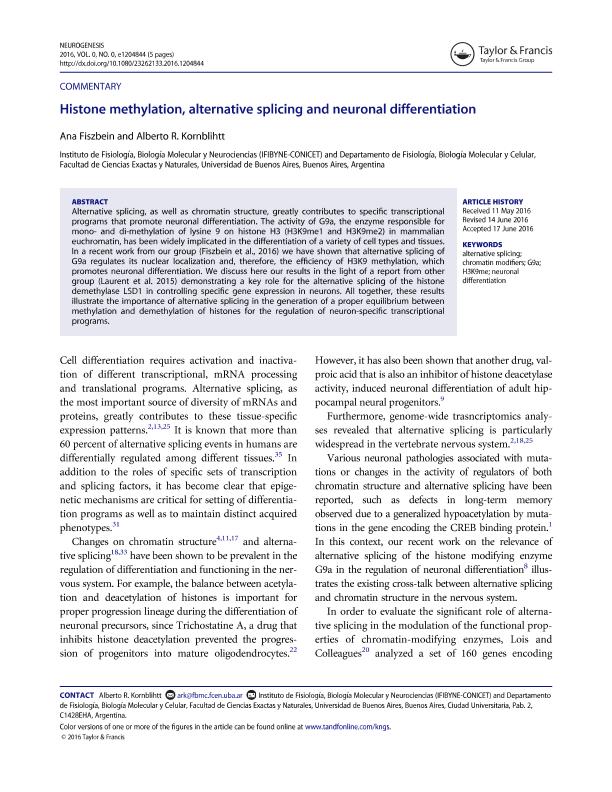Artículo
Histone methylation, alternative splicing and neuronal differentiation
Fecha de publicación:
06/2016
Editorial:
Taylor & Francis
Revista:
Neurogenesis
ISSN:
2326-2133
Idioma:
Inglés
Tipo de recurso:
Artículo publicado
Clasificación temática:
Resumen
Alternative splicing, as well as chromatin structure, greatly contributes to specific transcriptional programs that promote neuronal differentiation. The activity of G9a, the enzyme responsible for mono- and di-methylation of lysine 9 on histone H3 (H3K9me1 and H3K9me2) in mammalian euchromatin, has been widely implicated in the differentiation of a variety of cell types and tissues. In a recent work from our group (Fiszbein et al., 2016) we have shown that alternative splicing of G9a regulates its nuclear localization and, therefore, the efficiency of H3K9 methylation, which promotes neuronal differentiation. We discuss here our results in the light of a report from other group (Laurent et al. 2015) demonstrating a key role for the alternative splicing of the histone demethylase LSD1 in controlling specific gene expression in neurons. All together, these results illustrate the importance of alternative splicing in the generation of a proper equilibrium between methylation and demethylation of histones for the regulation of neuron-specific transcriptional programs.
Palabras clave:
Alternative Splicing
,
Chromatin Modifiers
,
G9a
,
H3k9me
,
Neuronal Differentiation
Archivos asociados
Licencia
Identificadores
Colecciones
Articulos(IFIBYNE)
Articulos de INST.DE FISIOL., BIOL.MOLECULAR Y NEUROCIENCIAS
Articulos de INST.DE FISIOL., BIOL.MOLECULAR Y NEUROCIENCIAS
Citación
Fiszbein, Ana; Kornblihtt, Alberto Rodolfo; Histone methylation, alternative splicing and neuronal differentiation; Taylor & Francis; Neurogenesis; 3; 1; 6-2016; 1-5; e1204844
Compartir
Altmétricas




